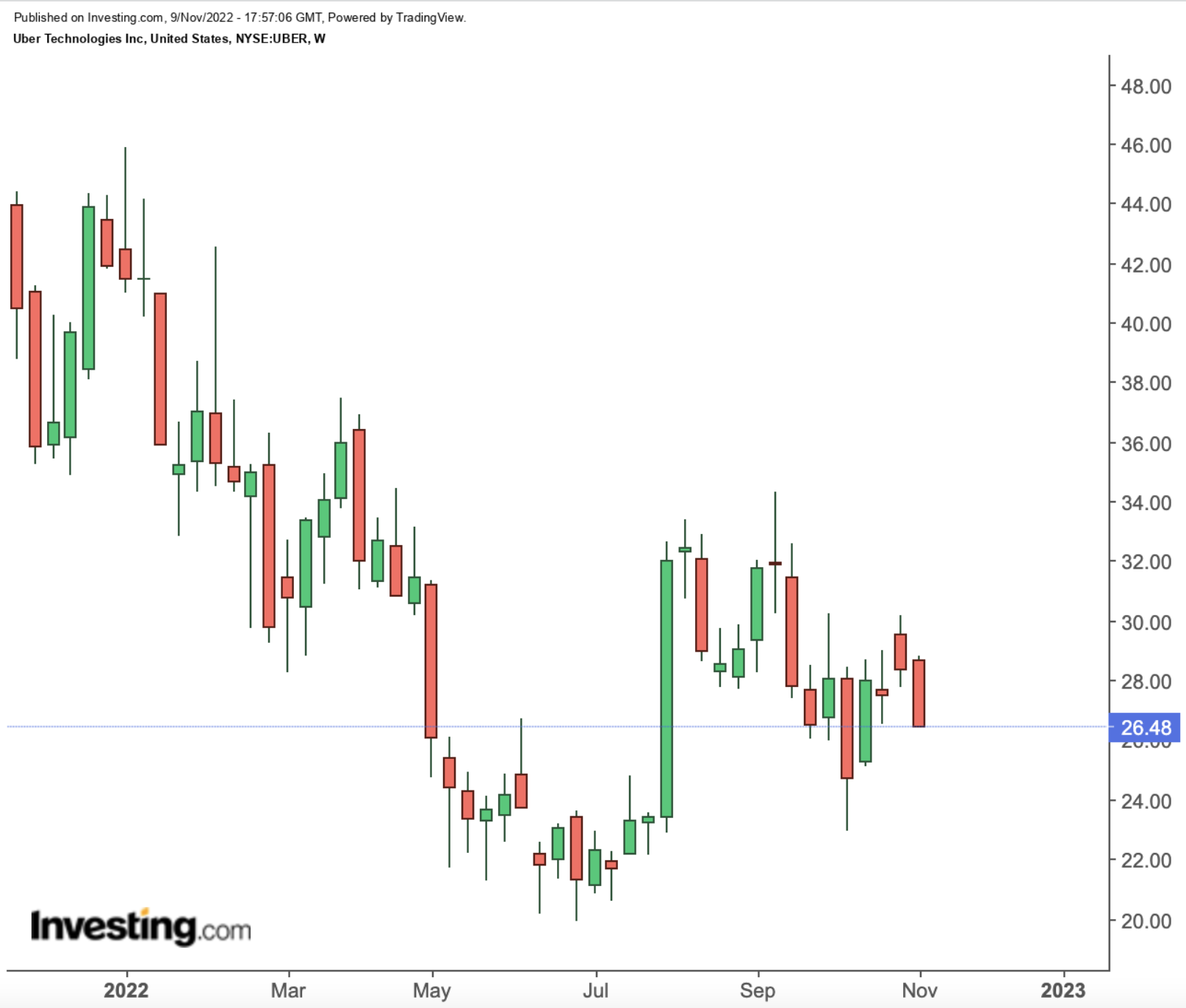Uber: Right Track, Wrong Valuation
2022.11.09 14:05
[ad_1]
- Uber’s third-quarter report showed continued progress toward profitability
- The economics of the platform model suggest room for significant profit growth
- Investors still are paying dearly — too dearly — for a company with a lot of work left to do
Uber (NYSE:) finally appears headed in the right direction. Negativity seemingly has surrounded the company for years. Controversial founder Travis Kalanick stepped down in 2017 amid a wide-ranging internal investigation. The company spent the next years preparing for its initial public offering — which promptly flopped. Shares traded down on their first day, and closed 2019 down 34% from their IPO price.
The novel coronavirus pandemic followed, hitting demand in the ride-sharing business. Uber burned $8 billion in cash across 2020 and 2021. A brief return above the IPO price was then reversed amid a market selling off pretty much every growth stock in sight.

Source: Investing.com
After that rough stretch, however, Uber finally seems to be on track. Indeed, it’s hard not to be at least a little impressed by the company’s last week. A company that, for all its warts, always offered massive potential finally seems to be realizing at least some of that potential.
Adjusted EBITDA (earnings before interest, taxes, depreciation and amortization) continued its march into the black. The delivery business is doing well. And it certainly seems like Uber is taking market share in ride-sharing.
There’s real good news here. The concern, however, is how much good news remains priced in.
The Business Starts to Work
Back in 2019, Uber’s IPO valued the company at $82.4 billion. That was an incredible figure for a company nowhere near profitability, even on a heavily adjusted basis.
Three years later, however, Uber actually is profitable, at least depending on an investor’s definition. Adjusted EBITDA in Q3 was $516 million — up from just $8 million the year before. Uber is guiding for $600 million to $630 million in the fourth quarter, in the range of seven times the year-prior result.
Skeptics will rightly point out that adjusted EBITDA paints the company in the best possible light. Most notably, it excludes share-based compensation, which totaled $432 million. Uber’s free cash flow for the quarter was $358 million; all of that cash flow, and then some, came from the issuance of stock to employees.
All that said, this is real progress. In the fourth quarter of 2019, Uber’s adjusted EBITDA was a loss of $615 million. Guidance, thus, implies a swing of roughly $1.2 billion in just three years.
It’s not just ride-sharing, either. The delivery business has reversed from massive initial losses to a profit (again, on an adjusted basis). The freight business increased revenue more than 300% in Q3.
Cause for Optimism
What makes UBER intriguing here is that this trend highlights the positive economics of a platform business. Each incremental ride, delivery or freight booking that Uber generates should, in theory, be exceptionally profitable. Once the ride-sharing system is set up, for instance, the marginal cost of one more ride is negligible. Drivers need to get paid, of course, and there are other costs involved, but Uber’s profit margins, in theory, should expand at a rapid clip as revenue grows.
And for the most part, that’s what we’re seeing. The delivery business went from losing 50 cents on every dollar in revenue in Q3 2019 to earning more than six cents in the same quarter three years later.
That trend should continue in delivery; ride-sharing margins can expand, particularly if Uber takes more market share from rival Lyft (NASDAQ:). And on the back of a few billion in annual revenue, plus continued 20%-plus growth, Uber’s EBITDA over time should move from simply covering stock-based compensation to generating real value for shareholders.
The Case for Patience
The problem with UBER stock is that this case is not exactly hidden. The market is pricing in pretty significant profit growth.
This remains a company with a market capitalization of $49 billion. Q4 guidance suggests free cash flow might be barely positive when accounting for stock-based compensation.
And it’s worth noting as well that the macroeconomic environment likely is helping to at least some degree. Despite inflation, consumers are spending. Indeed, Uber chief executive officer Dara Khosrowshahi said on the Q3 conference call that “frankly, we’re not seeing any signs of consumer weakness.”
That may change. As the CEO of rival Lyft put it, $30 salad delivery can’t last forever in an inflationary environment. Travel demand is near a peak as well.
Investors can see value here, admittedly. It’s possible to model multi-year growth of free cash flow in the several-billion-dollar range — more than enough to suggest solid upside from the current price.
But Uber’s macroeconomic exposure means growth isn’t necessarily going to be in a straight line. And it’s not guaranteed to be fast enough to make the stock a steal at $27. Uber has done a nice job so far this year, but investors still can remain patient.
Disclaimer: As of this writing, Vince Martin has no positions in any securities mentioned.
[ad_2]
Source link








